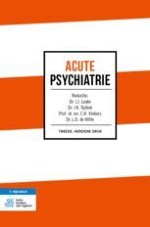Samenvatting
In het hoofdstuk Acute bewegingsstoornissen worden de epidemiologie, aandachtspunten bij anamnese en lichamelijk onderzoek, differentiaaldiagnose en behandelopties besproken. Het beschrijft drie frequent voorkomende acute bewegingsstoornissen door psychofarmaca: acute dystonie, acute acathisie en parkinsonisme. Acute dystonie is een abnormale houding of spasme van de spieren en kan in alle spiergroepen optreden, maar meestal in het hoofdhalsgebied. Acute dystonie uit zich vaak met een veranderde houding of stand en kan leiden tot pijn, onrust en/of angst. Soms is er alleen een strak gevoel in de tong of keel. Acute dystonie kan gedurende de dag variëren of bewegingsafhankelijk zijn. Acute dystonie wordt meestal veroorzaakt door het starten of verhogen van een antipsychoticum en ontstaat binnen 7 dagen. Acute dystonie kan ook ontstaan bij het starten of verhogen van andere dopamine-antagonisten, zoals bepaalde anti-emetica, of het plotseling staken van anticholinergica en in een zeldzaam geval door gebruik van antidepressiva, lithium, cocaïne en anticonvulsiva. Een oculogyrische crisis kan ook later ontstaan bij een stabiele dosering antipsychoticum. Hierbij is de uitlokkende factor vaak stress of emotie waardoor de dystonie soms ten onrechte als psychogeen geïnterpreteerd wordt. Een oculogyrische crisis duurt meestal enkele minuten tot een kwartier en komt vaak terug. Laryngospasme is een zeldzame maar levensbedreigende vorm van acute dystonie.
